
 |
| Solid State & LED Displays |
By the beginning of the 1970s, LED indicators started to evolve into LED displays. The earliest LED displays are constructed of dozens of small indicator-style dies, while later displays are constructed from more complicated multi-segment dies, eventually settling on the now standard practice of using a single LED with a diffuser for each segment. Simple displays were quickly joined by LED intelligent displays, which incorporated integrated circuits directly into the LED package, allowing for a progression of smaller and more complex LED devices. |
|
| Hewlett Packard 5082-7000 | |
Hewlett Packard's 5082-7000, manufactured in 1969, is believed to be the first smart LED display (ie, a display that includes it's own decoder chip), to ever be commercially produced, as well as HP's first LED display. Hewlett Packard largely ignored the trends then current in IC fabrication and constructed the 5082-7000 in a hermetic metal bathtub package. The digits in this device are somewhat stylized--each is equipped with an extra row of LED dies to allow for the generation of more natural representations of the '4' digit. Very few displays offer this feature, as it significantly increases the number of dies necessary to display a digit. Each of the dies was placed by hand, with tweezers, by HP's team of assemblers. This helps to explain the display's original list price of $75 dollars per unit, a substantial amount of money for 1969. The display includes a built in BCD decoder, which is located above the displayed digit. The leads of this device are attached to the metal can enclosure with glass beads and an internal ceramic substrate acts as a base for the display's internal gold traces. This display was made in both white and gray ceramic versions, the white version is shown here. Note the large metal heatsink mounted under the display, which dissipates the substantial amount of heat this device generates. The 5082-7000 saw use in a historically significant device, Hamilton's 'Pulsar' first generation LED watch. In order for the bulky 7000 series displays to be fit into the watches' casing, Hamilton had special reduced-size ceramic billets constructed by a 3rd party company, which were then sent to HP for installation of the LED dies and proprietary controller ICs. Hewlett Packard 5082-7000 Datasheet (PDF, 415kb) | 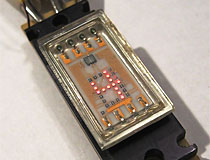 |
| Hewlett Packard 5082-7001 | |
This is a three digit analogue of the single digit Hewlett Packard 5082-7000 smart display shown above. As with the device above, this display is enclosed in a hermetic metal can package and contains an extra set of LED dies for use in the display of the '4' character. The most unusual aspect of this device is the use of a separate BCD driver IC for each digit; nearly every multi-digit smart LED display uses a single chip to drive all of the digits, to save on silicon. Each digit is also installed on a separate purple ceramic wafer. The choice of a metal enclosure is not purely a cosmetic one; the heat generated by this display when in operation is not insignificant. The 1971 Hewlett Packard price guide lists a single quantity value for this display of $165, making it one of the most expensive LED displays of its time. Hewlett Packard 5082-7000 Datasheet (PDF, 415kb) | 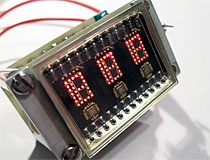 |
| National Semiconductor NSA578 | |
The NSA578 is an example of the next step in display evolution after single digit displays like the MAN-1, as it incorporates all seven segments into a single die. Such displays were popular for early pocket calculators and watches, where the small size of the numerals did not cause a hindrance to operation. The NSA578 contains seven digits, each whole digit is etched on a single die, and soldered to a standard PCB backing. The dies' leads are connected to tracks on the PCB by fine wires, similar to the die connections used in most semiconductor chips. The display's decimal points are separate dies, each with their own PCB pad and connecting wire. Due to the small size of single-die digits, most such assemblies used an external magnifier to make the digits more readable. The NSA758 is unusual in that it does not have an external magnifier. Instead, a red plastic cover is the only barrier between the dies and the outside world. Here is an image of the display with the cover removed, which reveals the single-die digits. | 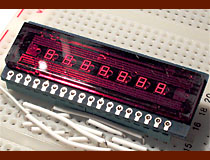 |
| Hewlett-Packard 5082-7300 Series | |
Devices included in this entry: | 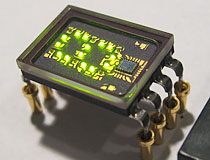 |
| Litronix DL1414 & Hewlett Packard HPDL1414 | |
Devices included in this entry: Siemens DL1414 Datasheet (PDF, 365kb) | 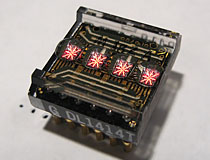 |
| Soviet 490IP1 | |
Have you ever wanted a smart LED display that could easily be lost in your pocket? The 490IP1 LED, produced in the former Soviet Union, is a likely contender for the smallest smart LED display in the world. This display has a built in decimal counter and 7 segment encoder etched into a single die, which can be easily seen through the LED's glass front. This display is insanely small; the digit height is only 2.5mm and this device is a tiny fraction of the size of electrically comparable decimal counter LEDs such as the Texas Instruments TIL306. The 490IP1 has a maximum counting speed of 1MHz as well as a carry output that allows multiple LEDs to be chained together. In effect, this LED can be thought of as a functional replacement for the Elesta EZ10B dekatron counting tube, though since the 490IP1 is not filled with chronically leaky hydrogen gas, it is likely a much more robust device. Since the display area of the 490IP1 is very small, the Soviets produced a companion external magnifier designed to work with this LED. The magnifier would clip to the outside of the display and provide a bubble lens over the digit area, to make the display easier to read. | 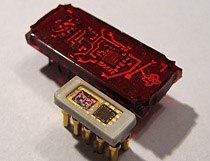 |
| Hewlett-Packard HDSP-2112 Series | |
Devices included in this entry: | 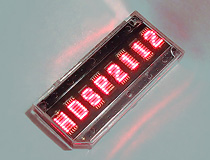 |
| Hewlett-Packard HDSP-2xxx Series | |
Hewlett-Packard HDSP-2010 red intelligent LED display (12-pin red glass-on-ceramic DIP) | 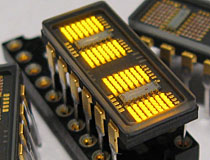 |
| RFT VQC10 | |
In spite of prevailing evidence, not all LED smart displays were made by Litronix and Hewlett-Packard. RFT, based in Germany, also made smart displays such as this one, the VQC10. Packaged in an attractive red molded epoxy package, the VQC10 has four characters, each containing 35 LED dies arranged in a 5x7 matrix. Unlike many other smart displays, the VQC10 has no built in character driver or other advanced features. The display uses an extremely convoluted control scheme, rows across all digits are ganged together and controlled manually, while each column can be selected by sending a 9 bit address in parallel to the display's driver circuitry. The home experimenter should take note that the VQC10 has wider pin spacing than most DIP LED displays, and will not fit in a conventional breadboard or socket. VQC10 (VQC 10) Datasheet (PDF, 133kb) | 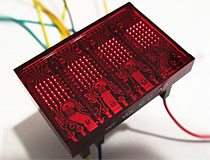 |
| Texas Instruments TIL308 | |
Though the Texas Instruments TIL308 appears externally identical to TIL306, internally it is quite different. The TIL308 lacks a built in decade counter, instead it accepts BCD hexidecimal data directly, a much more flexible arrangement. The TIL308 family was in fact both the forerunner and quickly superseded by the smaller and much more popular TIL311 BCD display shown below, and as such saw limited use. The TIL308 includes several features not found in the TIL311 however, including a built in display test function as well as data outputs for the display's built in latch. Several extra pins are present on the bottom of the package in order to provide access to these additional functions. Texas Instruments TIL308 Datasheet (PDF, 117kb) | 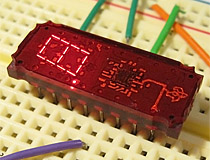 |
| ©2000-2025 Industrial Alchemy. All rights reserved. | Switch to mobile version | Contact | |  |